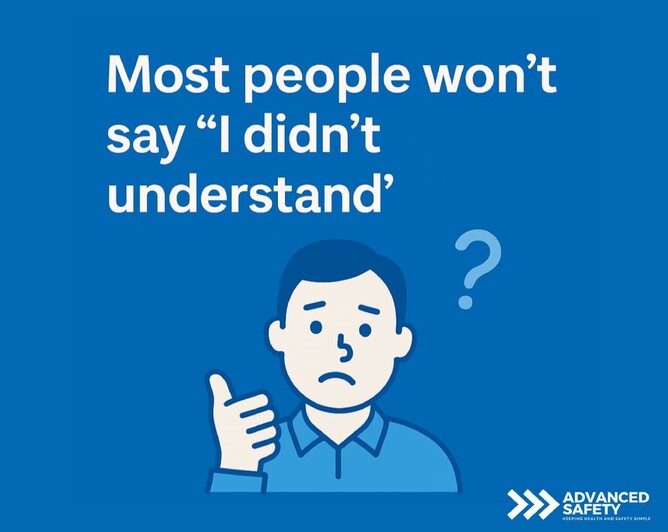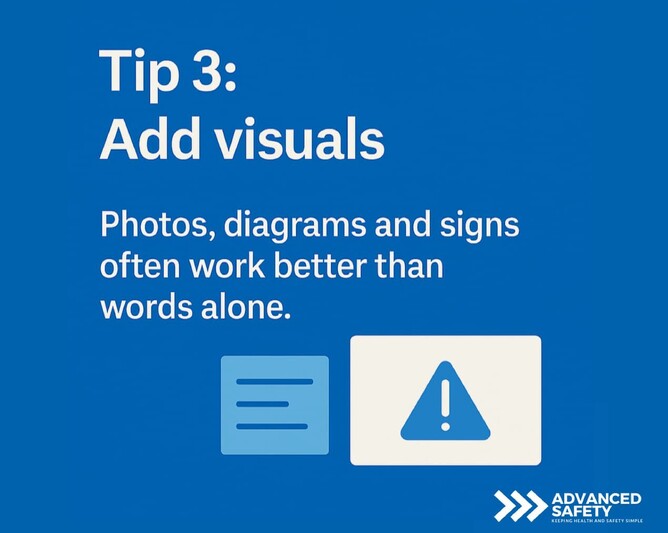Effective communication is one of the most under-leveraged safety tools in business. With 15–20% of the population considered neurodivergent and the average reading age in New Zealand sitting between 12–14 years, clarity in messaging is no longer a “nice to have” - it’s non-negotiable.
This blog explores four inclusive communication tips for safer workplaces that will help your teams understand, engage, and take action - no matter their learning style, background, or neurodiversity profile.
Why Inclusive Communication Matters
Before diving into the practical tips, it’s important to understand the context.
Neurodiversity encompasses ADHD, autism, dyslexia, and more.
Many individuals won’t speak up if they don’t understand—especially in group settings or when under pressure.
Misunderstandings in health and safety communication can lead to real-world harm.
“Most people won’t say, ‘I didn’t understand.’ They’ll just nod. Then do it their way.”
By shifting the way we communicate, we make our workplaces safer, more supportive, and ultimately more successful.
This is not just about being politically correct or overly accommodating. It's about designing communications that work for everyone -regardless of learning styles, literacy levels, or cultural background. In health and safety, this isn't just best practice -it's lifesaving.
When communication is clear, people can follow instructions. When it's confusing, they fill in the blanks themselves. That's where risk creeps in. Add pressure, time constraints, or stress -and those blanks become hazards.
We often think policies, forms, and systems are enough. But if the average worker can’t understand what’s being asked, then the best system in the world won’t deliver results. Inclusive communication is a proactive safety measure—it stops incidents before they happen.
By shifting the way we communicate, we make our workplaces safer, more supportive, and ultimately more successful. It's not a change in content -it's a change in mindset. Clear communication is inclusive communication. And inclusive communication is effective communication.
That’s why we’ve created this guide: to give you four simple, proven ways to make your workplace communication stronger, safer, and more inclusive -starting today.
Inclusive communication tips for safer workplaces - Tip 1: Ditch the Jargon
When we talk about workplace safety, it's easy to fall into the trap of jargon. Terms like "operational oversight", "site-specific risk register", or "administrative controls" might be familiar to us in the field - but to the person on the floor, they can sound like a different language.
If someone doesn’t understand what you're saying, it doesn't matter how correct or compliant the message is. Clarity beats complexity every time.
Inclusive communication starts with using everyday language. Swap “implement” for “use.” Replace “facilitate” with “help.” Think about how you’d explain it to someone at a BBQ - that’s your tone.
Also consider translation - not just into other languages, but into meaningful terms for different departments. What makes sense to a manager might be confusing to a temp worker on their first day.
By ditching jargon, you break down barriers. You invite engagement. And most importantly, you help make sure your message sticks.
Your goal isn’t to sound clever - it’s to be understood. That’s where safety starts.
Inclusive communication tips for safer workplaces - Tip 2: Use Short Sentences
Long-winded explanations slow people down. Worse, they can cause confusion - especially in high-risk or time-sensitive environments.
Short sentences are powerful. They help reduce mental load and make it easier for everyone to stay on track.
One sentence = one idea.
That’s the rule of thumb.
It’s also critical for anyone with ADHD, dyslexia, or cognitive fatigue. They often find dense paragraphs difficult to process, especially when trying to follow steps or safety protocols.
Break things up. Use white space. Use bullet points. And always, always lead with the most important message first.
Consider this example:
Before: “All operators must ensure that prior to the commencement of work on any machinery, a pre-start safety checklist has been completed in accordance with the documented process located within the compliance binder.”
After: “Complete the pre-start checklist before using any machine. The checklist is in the compliance binder.”
The result? Clearer communication. Faster decisions. Fewer mistakes.
You’re not removing detail - you’re removing noise. And that makes all the difference.
Inclusive communication tips for safer workplaces - Tip 3: Add Visuals
Visuals are not just decorative - they’re functional tools that help people absorb and retain information.
Research shows that people remember 80% of what they see, compared to just 20% of what they read. That’s a game-changer for health and safety.
For neurodivergent individuals, particularly those who are visual learners or who process information differently, images can provide clarity where words might fall short.
Try using icons, diagrams, step-by-step illustrations, or even short videos. A picture of correct PPE usage beats a paragraph describing it. A labelled diagram of a machine’s emergency stop button is far more effective than a line of text.
Another bonus? Visuals overcome language barriers. Your workforce may include people with varying literacy levels or different native languages. Images bridge those gaps instantly.
In your training materials, SOPs, site signage, and even digital forms - ask yourself, “What can I show instead of explain?”
When you prioritise visuals, you make your communication more universal. And that helps everyone stay safer, faster.
Inclusive communication tips for safer workplaces - Tip 4: Check for Understanding
The most common phrase at the end of a briefing? “Any questions?”
The most common response? Silence.
But silence doesn’t mean understanding. It might mean confusion. Or embarrassment. Or fatigue.
Inclusive communication means actively confirming comprehension - not passively hoping for it.
One method is the teach-back technique. Ask your team to explain the key points back to you, in their own words. If they can’t, the message probably needs to be simplified or clarified.
You can also ask scenario-based questions. “What would you do if X happened?” is far more revealing than “Did you get that?”
This is especially helpful for neurodivergent workers who may struggle with verbal cues or unstructured instructions. Creating a routine where feedback and interaction are encouraged - and expected - makes your communication more effective for everyone.
It also shows respect. You’re saying, “Your understanding matters.”
Check for understanding, not to catch people out - but to lift everyone up.
Let’s Make Your Communication Work Smarter
This isn’t about redoing all your systems or hiring consultants to rewrite everything. It’s about making intentional changes that increase clarity and reduce harm.
Start with one change: a rewritten bulletin. A simplified SOP. A visual checklist.
Then build from there.
These four inclusive communication tips for safer workplaces - ditching jargon, shortening sentences, adding visuals, and checking for understanding - are simple to implement but powerful in effect.
At Advanced Safety, we help businesses embed these principles into their day-to-day. Not just for compliance - but for real-world results.
Book a call to explore how we can help you build a more inclusive, effective, and safer workplace - one word at a time.
Want to discuss your safety goals?
Contact Advanced Safety for professional guidance and support.
Contact Us Today






